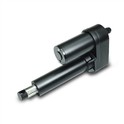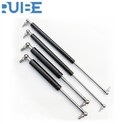Can a linear actuator be customized? You bet it can! As a linear actuator supplier, I've seen firsthand the diverse needs of our customers, and customization is often the key to meeting those unique requirements. In this blog post, I'll dive into the world of linear actuator customization, sharing insights on why it's important, what can be customized, and how we go about making it happen.
Why Customization Matters
Let's face it, off - the - shelf linear actuators are great for many standard applications. But in a lot of real - world scenarios, one size doesn't fit all. Different industries, projects, and even individual users have specific needs that a generic actuator just can't meet.
For example, in the industrial automation sector, some production lines require extremely high - speed linear motion with precise positioning. A standard actuator might not be able to achieve the required speed or accuracy. On the other hand, in the medical field, actuators used in patient - handling equipment need to be not only reliable but also quiet and hygienic. Customization allows us to design actuators that tick all these boxes.
In the consumer electronics industry, products like adjustable desks and Linear Actuator for Tv Lift demand actuators that are compact, efficient, and easy to integrate. By customizing linear actuators, we can ensure that they fit seamlessly into these products, enhancing the user experience.
What Can Be Customized
1. Stroke Length
The stroke length is the distance that the actuator can extend and retract. Standard actuators come with predefined stroke lengths, but for many applications, a custom stroke length is necessary. For instance, in a robotic arm, the stroke length of the actuator determines the range of motion of the arm. We can adjust the stroke length according to the specific requirements of the project, whether it's a few millimeters for a precision instrument or several meters for a large - scale industrial machine.
2. Load Capacity
Load capacity is another crucial factor. Different applications require actuators to handle different weights. A Heavy Duty Linear Actuator might be needed in construction equipment to lift heavy loads, while a lighter - duty actuator is sufficient for a small - scale automation project. We can customize the internal components, such as the motor, gears, and screw, to increase or decrease the load - handling capacity of the actuator.
3. Speed
The speed at which an actuator moves can also be customized. Some applications, like high - speed sorting machines in a warehouse, need actuators that can move quickly. Others, such as a slowly adjustable hospital bed, require a slower and more controlled movement. By adjusting the motor speed and the gear ratio, we can fine - tune the speed of the linear actuator to match the application's needs.
4. Mounting Options
Proper mounting is essential for the efficient operation of a linear actuator. Depending on the installation environment, different mounting options might be required. We can design custom mounting brackets and interfaces to ensure that the actuator can be easily and securely installed in the desired location. This is especially important in complex machinery where space is limited and the actuator needs to fit precisely into a specific area.
5. Control Systems
The way an actuator is controlled can vary widely. Some applications might require simple on - off control, while others need more sophisticated control, such as proportional control or position feedback. We can customize the control system of the actuator, integrating sensors, controllers, and communication interfaces to provide the level of control required by the user. For example, an Electric Linear Actuator can be equipped with a programmable controller for precise and automated operation.


The Customization Process
1. Consultation
The first step in the customization process is a detailed consultation with the customer. We sit down with them to understand their project requirements, including the application, performance expectations, budget, and any other specific constraints. This helps us get a clear picture of what they need and allows us to provide initial suggestions and solutions.
2. Design and Engineering
Once we have a good understanding of the customer's needs, our engineering team gets to work on the design. We use advanced computer - aided design (CAD) software to create a 3D model of the customized actuator. This model allows us to visualize the design, check for any potential issues, and make necessary adjustments before moving on to the manufacturing stage.
3. Prototyping
After the design is finalized, we build a prototype of the customized actuator. The prototype is a working model that allows us to test the performance of the actuator in real - world conditions. We can check if it meets the specified stroke length, load capacity, speed, and other requirements. If any problems are found, we can make further modifications to the design.
4. Manufacturing
Once the prototype is approved, we start the mass production of the customized actuator. Our manufacturing facility is equipped with state - of - the - art machinery and quality control systems to ensure that each actuator is produced to the highest standards. We use high - quality materials and follow strict manufacturing processes to guarantee the reliability and durability of the actuators.
5. Testing and Quality Assurance
Before the actuators are shipped to the customer, they undergo a series of rigorous tests. These tests include performance testing, durability testing, and safety testing. We check for factors such as accuracy, repeatability, and resistance to environmental factors like temperature and humidity. Only after passing all the tests are the actuators considered ready for delivery.
Conclusion
In conclusion, linear actuators can definitely be customized, and it's a process that offers numerous benefits to our customers. Whether it's for industrial, medical, consumer, or any other application, customization allows us to provide actuators that are perfectly tailored to the specific needs of the project.
If you're in the market for a linear actuator and think that a customized solution might be right for you, don't hesitate to get in touch. We're here to help you through the entire process, from consultation to delivery. Our team of experts is ready to work with you to create the ideal linear actuator for your application. Contact us today to start the conversation and take your project to the next level.
References
- Linear Actuator Handbook: A comprehensive guide on the design, operation, and applications of linear actuators.
- Industry reports on the demand for customized linear actuators in different sectors.






